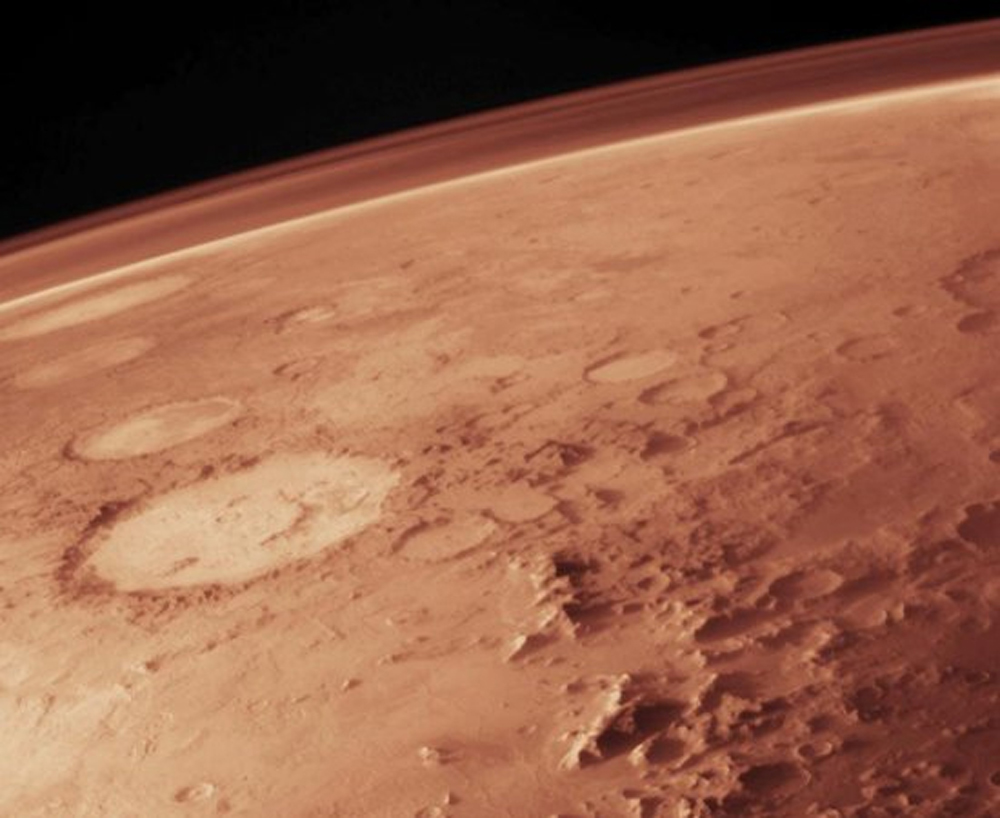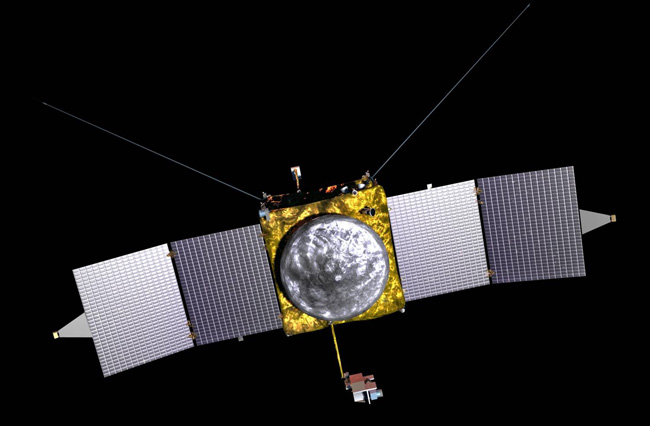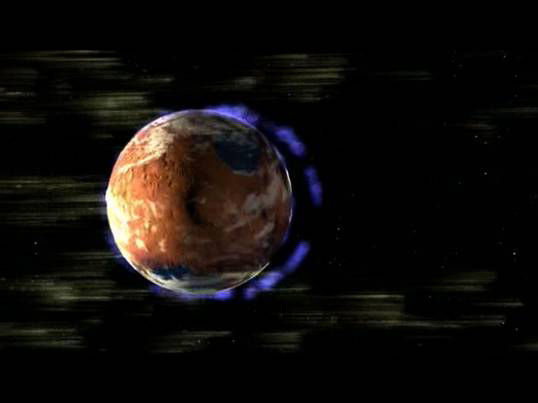New Spacecraft Will Hunt for Mars' Lost Water

A wet Mars is just a memory, but where did the water go?
Geological observations suggest rivers and seas dotted the Martian surface 3.5 billion years ago. The amount of water has been equated to a planet-wide ocean half-a-kilometer deep or more. For the planet to have stayed warm enough for liquid water, scientists assume that Mars had a greenhouse "blanket" of carbon dioxide atmosphere at least 1,000 times thicker than what Earth has now.
That carbon dioxide is mostly gone. So is the water. "Either they went up or they went down," said Dave Brain from UC Berkeley. [Photos: The Search for Water on Mars]
By "down," Brain is referring to the subsurface of the red planet. Water ice is known to be lurking underground, while vestiges of carbon dioxide can be found in the polar ice cap and in certain mineral deposits. But many scientists expect that a large fraction of the water-soaked atmosphere was sucked "up" into space.
"We know that escape is occurring today from the Martian atmosphere and that it has occurred in the past," said Bruce Jakosky of the University of Colorado, Boulder.

The current loss rate of Martian atmosphere is estimated to be around 100 tons per day, but this is based on incomplete data. Jakosky is leading a NASA mission called MAVEN that plans to fly to Mars in 2013 to measure all aspects of atmospheric escape.
MAVEN – which stands for Mars Atmosphere and Volatile EvolutioN – will not only provide a better handle on the current loss, but it will also provide a window on the past, by determining how the upper atmosphere controls the loss rate. [Video: Building MAVEN – How to Build a Mars Satellite]
Get the Space.com Newsletter
Breaking space news, the latest updates on rocket launches, skywatching events and more!
"The more we know about the loss rate now, the better we can extrapolate back in time when Mars was presumably warmer and wetter," said Michael Combi of the University of Michigan.
Combi and his colleagues model the outer envelope of Mars' atmosphere, called the exosphere, where particles make their "jump" into space. As part of NASA's Mars Fundamental Research program, they are working on a full three-dimensional simulation that can use MAVEN's observations to say how much water Mars has lost to space.
Leaky planet
The main ways that atmospheric particles can escape a planet's gravity are ion escape, neutral escape and impact erosion, explains Brain.
The last of these, impact erosion, was dominant around 4 billion years ago, when the terrestrial planets were bombarded with large pieces of space debris. Big "splashes" like these would have hurtled large volumes of atmosphere into space, while also introducing water and other material to the surface.

However, Mars managed to hold onto a considerable amount of atmosphere throughout the bombardment. We know this because the evidence of Martian water is 3.5 billion years old – when impacts had become less common. Scientists therefore have to look to other escape routes to explain where all the water went.
The best-measured mechanism is ion loss. This typically occurs when sunlight or a collision ionizes gas molecules in the upper atmosphere. The resulting ions are susceptible to the forces of electric and magnetic fields, which on Mars means that the solar wind can "pick up" the ions and drag them out into space.
ESA's Mars Express mission recently measured loss rates of a few grams per second for several ion species on Mars. This is about the same as the ion loss on Earth, which might seem surprising considering that Earth has a strong magnetic field for deflecting the solar wind.
However, Mars Express was measuring these rates during solar minimum when the sun produces less ionizing radiation and less wind-whipping solar storms. It's possible that the unprotected Martian atmosphere gets stripped faster during solar maxima or during more active periods in the sun's past.
Moreover, ion loss is only part of the picture. Mars is also vulnerable to the loss of neutral atoms due to its comparatively weak gravitational field. Neutral loss occurs on Mars in a variety of ways. Hydrogen atoms can have enough thermal energy to escape the planet's gravity. Heavier atoms, like oxygen, can also escape as a result of energetic chemical reactions or collisions.
Neutral flow
Neutral particles are hard to detect, so scientists have so far relied on indirect measures to estimate the neutral loss rate. The best constraint comes from 35-year-old data from the Viking mission. When the Viking landers plowed through the atmosphere on their way to the surface, they provided information on the density and other conditions of the upper atmosphere.
Combi and his colleagues incorporate this Viking data into their model of the upper atmosphere. Their computer simulations focus on certain chemical reactions that are driven by sunlight. The reaction products are energetic atoms, some of which can escape into space if they reach an altitude where collisions with other gas particles become unlikely.

In their model, Combi's group has to take into account the daily and seasonal changes in sunlight hitting different parts of the atmosphere. They also consider the effect of the variations in solar activity over the 11-year solar cycle. [Best (and Worst) Mars Landings of All Time]
A recent calculation by Combi's group found the loss rate of neutral oxygen atoms should be about 100 times greater than the ion loss measured by Mars Express. Taking this as their baseline, the researchers estimate that Mars could have lost a 10-meter-deep layer of water from its surface over the last 3.5 billion years.
But estimates like these are speculative, as they are based on an incomplete picture of the Martian upper atmosphere. A data upgrade is needed.
Cravin' for Maven
"The MAVEN mission is the first to have as its sole focus understanding the nature of the upper atmosphere and how it controls the escape rates," Jakosky said.
The $485-million MAVEN will carry eight instruments to measure ion and neutral escape, as well as the structure and composition of the upper atmosphere. Over its planned two-year mission, it will also monitor the solar wind, solar ultraviolet, and solar storms, which are the main drivers that influence the rate at which material is stripped off the Martian atmosphere.
"We have never before had all the right instruments on one spacecraft," Brain says.
One of the challenges of past missions has been characterizing a "leak" that is spread over the entire 150,000 square kilometers on Mars' outer atmospheric surface. MAVEN's orbit will be varied in such a way that it samples the loss rate from a wide range of different latitudes, as well as at different times of the day.
Still, the satellite can only be in one place at one time, so models like that of Combi's group are needed to fill in the gaps.
"These models are absolutely essential for us," Jakosky said. "They will allow us to take the MAVEN measurements that are made at discrete times and locations and extrapolate them to other times and places."
When trying to imagine loss rates long ago, researchers will have to account for changes in the solar output. By observing sun-like stars at earlier stages in their lives, astronomers believe our Sun was more active in the past – with more storms and greater ultraviolet flux. Consequently, atmospheric escape should have been ramped up on high as well.
"We can't measure what the atmosphere was like billions of years ago," Jakosky said. "However, we can measure it today, measure how the processes that control it work, and then use models to extrapolate to other conditions."
So in the end, the models need the satellite to ground them in reality. And the satellite needs the models to stretch its reach to the beginning of Martian history.
Only then will Mars spill the secret of its lost water.
This story was provided by Astrobiology Magazine, a web-based publication sponsored by the NASA astrobiology program.
Join our Space Forums to keep talking space on the latest missions, night sky and more! And if you have a news tip, correction or comment, let us know at: community@space.com.

Michael Schirber is a freelance writer based in Lyons, France who began writing for Space.com and Live Science in 2004 . He's covered a wide range of topics for Space.com and Live Science, from the origin of life to the physics of NASCAR driving. He also authored a long series of articles about environmental technology. Michael earned a Ph.D. in astrophysics from Ohio State University while studying quasars and the ultraviolet background. Over the years, Michael has also written for Science, Physics World, and New Scientist, most recently as a corresponding editor for Physics.









